Visualize editing strategies to extend custom libraries
Author: The Little Dream, Created: 2020-10-17 11:27:43, Updated: 2023-09-27 19:39:37
Visualize editing strategies to extend custom libraries
How can I extend the custom class library I need to the visualization strategy? For example, I want to calculate the MA indicator, but the system only comes with: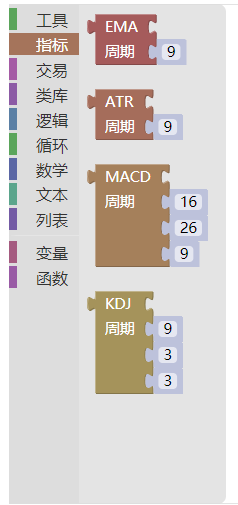 How can we add some custom code to these metrics?
We explain how to extend the visualization module by adding a custom MA indicator calculation module.
How can we add some custom code to these metrics?
We explain how to extend the visualization module by adding a custom MA indicator calculation module.
Directory of digital currencies
First of all, let's talk about the template for the cryptocurrency spot market repository, which is:https://www.fmz.com/strategy/10989Although the template is a template for the FMZ platform JavaScript language, students who do not understand the concept of a template can consult the FMZ API documentation:https://www.fmz.com/api#模板类库What is it? However, there is a commentary at the beginning of the template that defines the code for visualizing the module, and the code that defines the code can reference the code of this JavaScript template. This is very convenient for us to expand on our own (to give a good example, let's emulate).
The digital currency spot market library, the visual definition of the opening section:
/*blockly
{
"type": "ext_Trade",
"message0": "%1 币数 %2|%1 Coins %2",
"args0": [{
"type": "field_dropdown",
"options": [
["买入|Buy", "Buy"],
["卖出|Sell", "Sell"]
]
}, {
"type": "input_value",
"check": "Number"
}],
"template": "(function(){var r = $.%1(%2); return r ? r.amount : 0; })()",
"order": "ORDER_ATOMIC",
"output": "Number",
"colour": 85
}, {
"type": "ext_CancelPendingOrders",
"message0": "取消 %1 订单|Cancel %1 Orders",
"args0": [{
"type": "field_dropdown",
"name": "TYPE",
"options": [
["所有|All", " "],
["买单|Buy", "ORDER_TYPE_BUY"],
["卖单|Sell", "ORDER_TYPE_SELL"]
]
}],
"previousStatement": null,
"nextStatement": null,
"template": "$.CancelPendingOrders(%1);",
"colour": 85
}, {
"type": "ext_Cross",
"message0": "计算交叉 周期 %1 与 %2|Cross Period %1 and %2",
"inputsInline": true,
"args0": [{
"type": "input_value"
}, {
"type": "input_value"
}],
"template": "$.Cross(%1,%2)",
"order": "ORDER_ATOMIC",
"output": "Number"
}, {
"type": "ext_GetAccount",
"message0": "获取资产信息|GetAccount",
"template": "$.GetAccount()",
"order": "ORDER_ATOMIC",
"output": null
}
*/
The modules on the visualized edit page correspond to: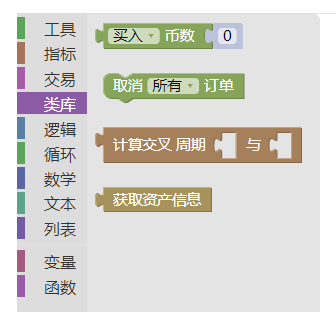
Build a module for calculating a self-defined MA indicator
With ready-made examples, it's easy to build your own with your own hands, even more so than painting a canvas.
First, a new template for the JavaScript language was created.
Edit the template code.
/*blockly
{
"type": "ext_testA",
"message0": "testA|testA",
"template": "function(){return 99;}()",
"order": "ORDER_ATOMIC",
"output": "Number"
},{
"type": "ext_MA",
"message0": "MA 周期 %1| MA Period %1",
"args0": [{
"type": "input_value",
"check": "Number"
}],
"template": "(function(){var r = exchange.GetRecords(); return (!r || r.length < %1) ? false : TA.MA(r, %1); })()",
"order": "ORDER_ATOMIC",
"output": null,
"colour": 85
}
*/
- type: The attribute defines the module type, which can be named on its own.
- message0: text displayed on the module.
- template: code executed by the module.
- output: the type of output of the module.
- args0: the input parameter of the module, in the module definition code %1 represents the first input parameter and %2 represents the second one.
This newly created template is saved after it has been edited.
In the policy where we need to use this template, select this template.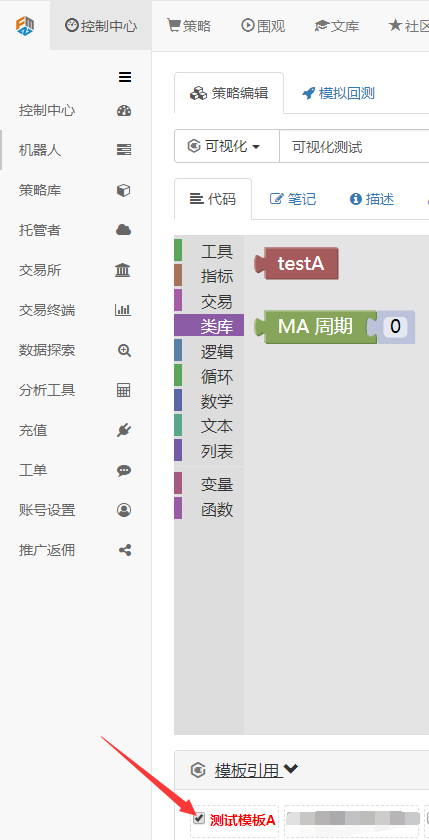
You can see two more modules:
-

The module is called testA, and let's look at its executable code:
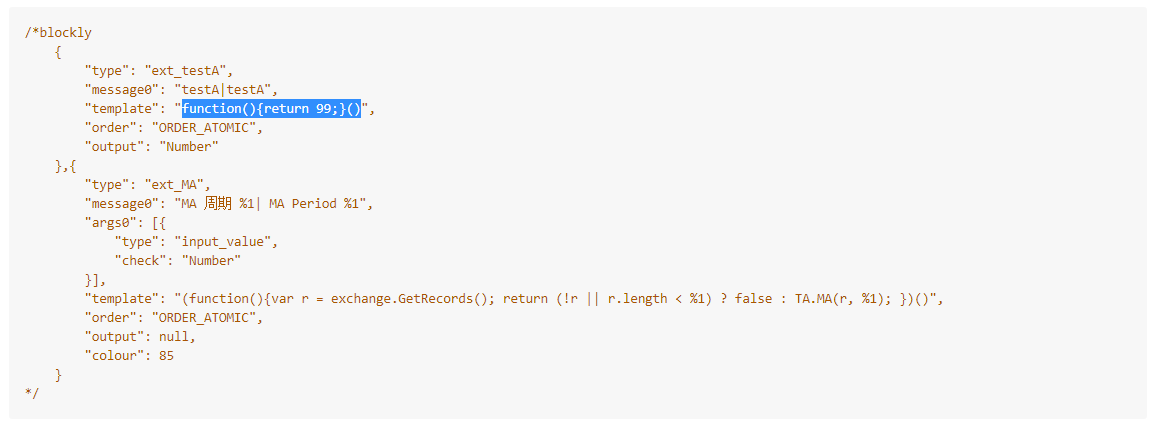
function(){return 99;}()A simple JavaScript function is executed and returns a value of 99.
-

It's called MA Cycle Module, and let's look at its execution code:
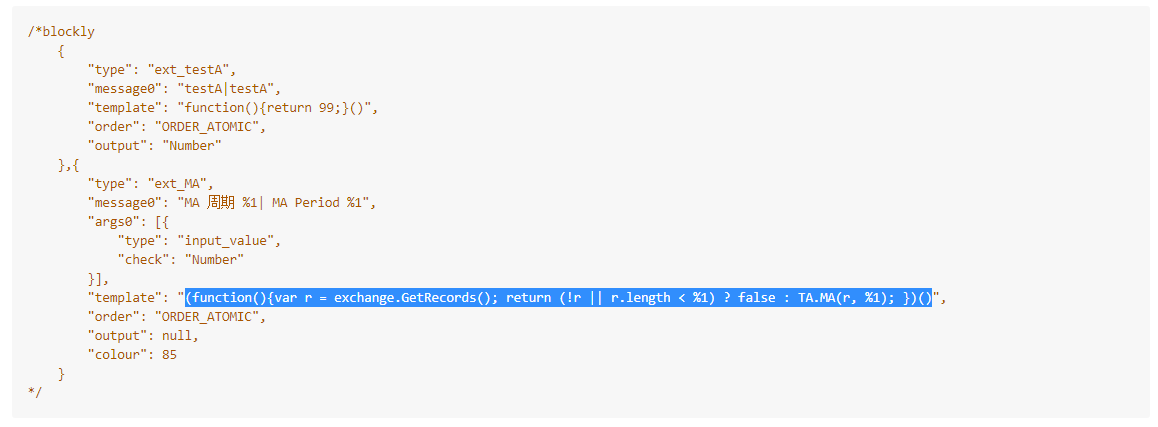
(function(){var r = exchange.GetRecords(); return (!r || r.length < %1) ? false : TA.MA(r, %1); })()The code is an anonymous function call, in which the anonymous function first performs the operation to obtain K-line data, K-line data.
rThen depending on whether the obtained r is fornullOrrThe length is less than the input parameter of the module%1Going back to judgingfalseOr go back.TA.MA(r, %1)The results of the calculation of the indicators.
I'm going to use it later.
The test calculates the MA indicator
This is the first time I've seen this video.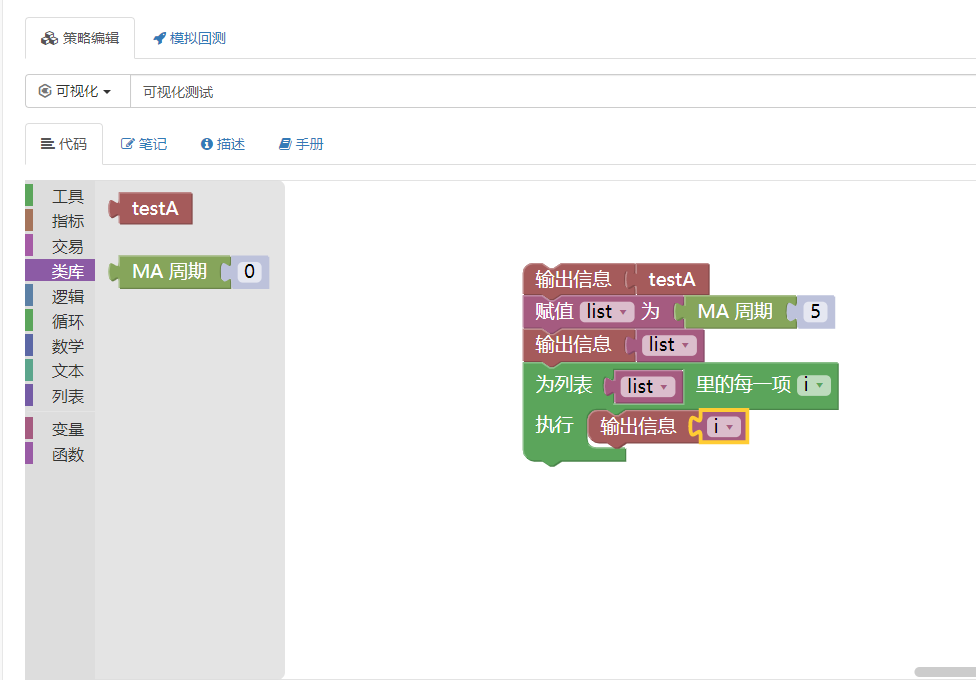
It runs:
As you can see above, the data for the calculation of the MA indicator was obtained on a pay as you go basis.
The above is just a parsing of the cube, for the design of the visualization module, the template function can be extended by itself.
- Quantifying Fundamental Analysis in the Cryptocurrency Market: Let Data Speak for Itself!
- Quantified research on the basics of coin circles - stop believing in all kinds of crazy professors, data is objective!
- The inventor of the Quantitative Data Exploration Module, an essential tool in the field of quantitative trading.
- Mastering Everything - Introduction to FMZ New Version of Trading Terminal (with TRB Arbitrage Source Code)
- Get all the details about the new FMZ trading terminal (with the TRB suite source code)
- FMZ Quant: An Analysis of Common Requirements Design Examples in the Cryptocurrency Market (II)
- How to Exploit Brainless Selling Bots with a High-Frequency Strategy in 80 Lines of Code
- FMZ quantification: common demands on the cryptocurrency market design example analysis (II)
- How to exploit brainless robots for sale with high-frequency strategies of 80 lines of code
- FMZ Quant: An Analysis of Common Requirements Design Examples in the Cryptocurrency Market (I)
- FMZ quantification: common demands of the cryptocurrency market design instance analysis (1)